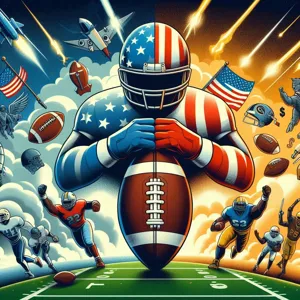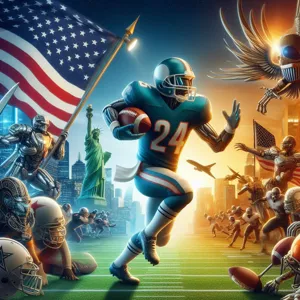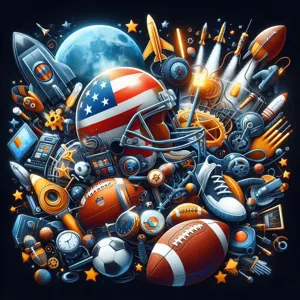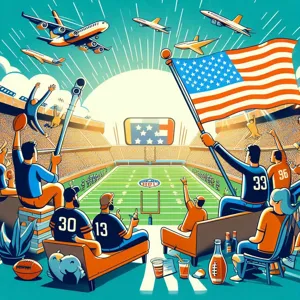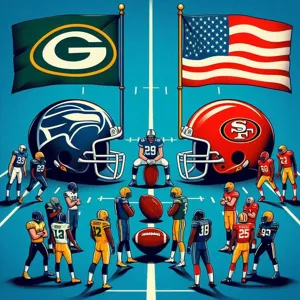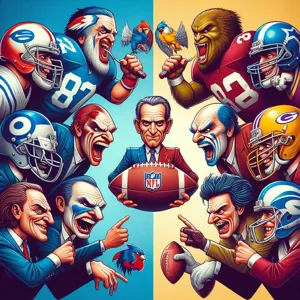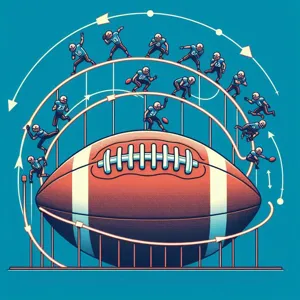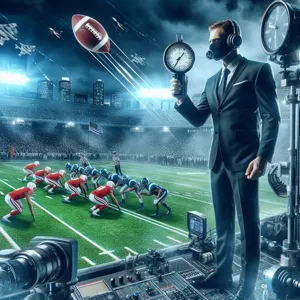The offside rule—one of soccer’s most debated and frequently misunderstood regulations—has been a cornerstone of the game since its inception.
Designed to promote fair play and fluidity, this rule has sparked countless discussions among players, coaches, and fans alike. Yet, as the game evolves and the pace quickens, many are questioning whether the offside rule still serves its intended purpose or if it stifles the natural flow of the sport. In this blog post, we will explore the intricacies of the offside rule, its historical context, and the arguments for and against its current application. With insights from experts and anecdotes from passionate soccer enthusiasts, we’ll delve into whether it’s time for a change that could redefine the beautiful game for future generations. Join us as we kick off this important conversation and consider the future of soccer’s most contentious rule!
1. Introduction to the Offside Rule

The offside rule is one of the most debated and misunderstood regulations in soccer, often sparking passionate discussions among players, coaches, and fans alike. Introduced to prevent attacking players from gaining an unfair advantage by positioning themselves too close to the opponent’s goal, the rule aims to preserve the integrity and flow of the game. In its essence, a player is deemed offside if, at the moment the ball is played to them, they are closer to the opponent’s goal line than both the ball and the second-to-last defender.
While this rule was established with the intention of promoting fair play, its application has evolved over the years, leading to confusion and controversy. Critics argue that the current interpretation can hinder the game’s natural rhythm, resulting in disallowed goals that can leave players and fans feeling cheated. The nuances of what constitutes “offside” have led to countless debates, with some calling for a reevaluation of the rule to better reflect the dynamic nature of modern soccer.
As we delve deeper into this topic, we’ll explore the historical context of the offside rule, its impact on gameplay, and the arguments for and against potential adjustments. With the ever-changing landscape of soccer, is it time to reconsider how we define offside, or does the rule serve its purpose in maintaining the fairness of the beautiful game? Join us as we unpack the complexities of this pivotal regulation and its implications for the future of soccer.
2. Historical Overview of the Offside Rule
The offside rule, one of soccer’s most debated regulations, has a rich and evolving history that reflects the sport’s development over the years. Originally introduced in the 19th century, the rule aimed to prevent “goal-hanging,” where players would linger near the opponent’s goal in an attempt to gain an unfair advantage. The first recorded version of the offside rule appeared in the Laws of the Game in 1863, established by the newly formed Football Association in England. At this time, a player was considered offside if they were nearer to their opponent’s goal line than both the ball and the second-last opponent when the ball was played to them.
As soccer gained popularity, so too did the need for clearer guidelines. Over the decades, the offside rule underwent several amendments, with significant changes occurring in the early 20th century. In 1925, the rule was altered to require only the last defender—rather than the last two—to be between the attacking player and the goal, effectively allowing more offensive play and changing the dynamics of the game significantly. This modification led to an increase in scoring and transformed how teams strategized on the field.
The evolution of the offside rule continued into the 21st century, with further refinements aimed at enhancing the flow of the game. The introduction of technology, such as VAR (Video Assistant Referee), has sparked renewed discussions about the rule’s nuances and its application in real-time scenarios. Critics argue that the offside rule can sometimes lead to controversial decisions that overshadow the beauty of the sport, while supporters maintain that it is essential for maintaining fairness and competitiveness.
Today, as soccer enthusiasts and analysts debate the future of the offside rule, its historical context serves as a reminder of how the game has adapted to changing times and the ongoing quest for balance between offense and defense. Understanding this history not only sheds light on the rule itself but also invites us to consider whether the time has come for yet another transformation in the beautiful game.
3. The Current Offside Rule Explained

The offside rule is one of the most discussed and often misunderstood aspects of soccer, and it plays a crucial role in determining the flow of the game. At its core, the rule is designed to prevent “goal-hanging,” or players lingering near the opponent’s goal waiting for a pass, which could lead to an unfair advantage. Understanding its nuances is essential for players, coaches, and fans alike.
According to the current offside rule, a player is in an offside position if they are nearer to their opponent’s goal line than both the ball and the second-to-last opponent (usually the last outfield player) at the moment the ball is played to them. However, simply being in an offside position does not constitute an offense. A player is only penalized for offside if they become involved in active play by interfering with an opponent, gaining an advantage from their position, or obstructing the goalkeeper’s view.
Referees have a challenging job when it comes to enforcing this rule, as they must make split-second decisions based on precise positioning and timing. The introduction of VAR (Video Assistant Referee) has added a layer of technology to assist referees in making these calls, but it has also sparked debates about the accuracy and fairness of offside decisions. The use of technology has led to instances of goals being disallowed for marginal offside calls, often measured in mere millimeters, raising questions about the spirit of the game.
As the sport evolves, many are beginning to question whether the current offside rule serves its intended purpose effectively. With the increasing speed and intensity of the game, some argue for a reevaluation of the guidelines to strike a better balance between attacking play and defensive organization. The ongoing discussions surrounding the offside rule highlight the need for a modern approach, one that considers the excitement of the game and the fairness of play. As soccer continues to capture the hearts of millions, the call for change may become increasingly prominent.
4. Common Misunderstandings of the Offside Rule
The offside rule is one of the most contentious and frequently misunderstood aspects of soccer, often leading to heated debates among fans, players, and even officials. At its core, the rule is designed to maintain fairness and promote fluid gameplay, but its nuances can leave many scratching their heads.
One common misunderstanding revolves around the concept of “active play.” Many people believe that a player is offside simply by being in front of the last defender when the ball is played. However, the rule states that a player is only offside if they are involved in active play—this means they must be interfering with an opponent or gaining an advantage from their position. This distinction is crucial and often overlooked, leading to incorrect assumptions about certain plays.
Another prevalent misconception is related to set pieces, such as corner kicks and free kicks. It’s a common myth that players cannot be offside during these situations. In reality, the offside rule still applies during set pieces; players can still be flagged for offside if they are positioned incorrectly when the ball is played.
Additionally, the idea that a player must have at least one foot on or behind the last defender when the ball is played is another point of confusion. While this is true for many, the interpretation can vary, especially when considering the position of the attacker’s body. For instance, if a player’s torso is in line with the defender while their feet are ahead, they are still considered onside due to the way the rule is framed.
These misunderstandings can lead to frustration among soccer enthusiasts, highlighting the need for clearer communication and education surrounding the offside rule. As the game evolves, so too should our understanding of its intricacies. Ultimately, a more informed fan base can foster greater appreciation for the sport and its rules, paving the way for more constructive dialogue about potential changes to the offside rule in the future.
5. Impact of the Offside Rule on Game Strategy

The offside rule has long been a cornerstone of soccer, shaping the very fabric of game strategy at every level of play. Its primary purpose is to prevent attacking players from gaining an unfair advantage by lingering near the opponent’s goal, and this fundamental principle has profound implications for how teams approach both offense and defense.
For attacking teams, the presence of the offside rule requires a delicate balance between timing and positioning. Strikers must develop a keen sense of awareness, constantly gauging their position in relation to the last defender while coordinating their runs with teammates. This often leads to intricate plays and clever movements, as players aim to exploit gaps in the defense without crossing the invisible line that could render them offside. Teams that master this art can create dynamic attacking formations, capitalizing on the slightest defensive lapses.
On the defensive side, the offside rule introduces a layer of complexity that shapes team formations and tactics. Defenders are often tasked with maintaining a high defensive line to catch attackers off guard, creating a risky yet strategic game of cat and mouse. This approach can produce exhilarating moments, but it also places immense pressure on defenders to be synchronized in their movements and to time their challenges perfectly. A miscalculation can lead to devastating one-on-one situations with the goalkeeper, underscoring the high stakes involved.
Moreover, the offside rule influences how coaches design their game plans. Some may opt for a more conservative strategy, prioritizing a compact defense that minimizes space for attackers, while others might encourage an aggressive pressing style that seeks to win the ball high up the pitch. The rule also affects substitutions; a coach might bring on a speedy forward to exploit defensive weaknesses or a seasoned player who excels in reading the game to shore up defensive efforts.
As discussions about the future of the offside rule continue, it’s clear that any changes could have sweeping implications for game strategy. A more lenient interpretation might encourage a more fluid attacking style, allowing for greater creativity and fewer interruptions. Conversely, stricter enforcement could lead to a resurgence of tactical discipline, with teams focusing even more on positioning and timing. Whatever the outcome, the offside rule remains a pivotal element that not only defines the game but also challenges teams to innovate and adapt their strategies in the quest for victory.
6. Controversial Offside Decisions: Notable Examples
In the world of soccer, few topics ignite as much debate and passion as the offside rule, especially when controversial decisions come into play. These moments can alter the course of matches, spark furious arguments among fans, and even influence tournament outcomes. Let’s take a closer look at some notable examples that have left players, coaches, and supporters questioning the validity of the offside rule as it stands.
One of the most infamous instances occurred during the 2010 FIFA World Cup, where England faced Germany in the Round of 16. In the first half, a shot from Frank Lampard struck the crossbar and bounced down clearly over the goal line before being cleared by the German defense. However, the referee waved the goal off, citing offside, despite clear evidence to the contrary. This controversial decision not only denied England an equalizer but also reignited discussions about the need for video technology in officiating.
Another striking example unfolded in the Premier League during a match between Manchester City and Tottenham Hotspur in 2019. In the dying moments of the game, Gabriel Jesus appeared to score a late winner for City, only for VAR to intervene and rule the goal out for offside. The ruling was based on the narrowest of margins, with replays showing that Jesus’s toe was just beyond the last defender. This decision led to uproar among fans and pundits alike, questioning whether such minute measurements should dictate the outcome of crucial matches.
Moreover, the 2020 UEFA Champions League clash between Atalanta and Valencia also showcased the potential pitfalls of the offside rule. A seemingly straightforward goal from Atalanta’s Josip Ilicic was initially flagged for offside, only for VAR to confirm that he was indeed onside. This back-and-forth sparked discussions about the fine line between technology’s assistance and the human element of officiating, leaving many to wonder if the current offside rule is outdated in the face of modern technology.
These examples highlight the ongoing challenges and controversies surrounding offside decisions in soccer. As technology continues to evolve, so too does the conversation around the offside rule and its implications on the game. Are these moments mere anomalies, or do they signal a broader need for reform in how offside is determined? The debate is far from over, and with every contentious decision, the call for change grows louder among players, coaches, and fans alike.
7. Arguments for Changing the Offside Rule

### Arguments for Changing the Offside Rule
The offside rule has long been a contentious topic in soccer, sparking debates among players, coaches, and fans alike. Advocates for changing the rule often present compelling arguments that highlight the evolving nature of the game and the need for it to adapt to modern play styles.
One of the most prominent arguments centers around the notion of fairness and excitement. Critics contend that the current offside rule can lead to frustrating moments where a goal is disallowed due to a player being marginally offside. This can detract from the overall enjoyment of the game, particularly in high-stakes matches where every goal counts. By adjusting the rule, proponents suggest, teams could be encouraged to adopt a more attacking style, resulting in more goals and thrilling plays, which ultimately enhances viewer engagement.
Additionally, the argument for change often includes the evolution of technology in officiating. With the introduction of VAR (Video Assistant Referee), the precision in determining offside positions has drastically improved. However, this has also led to lengthy stoppages in play, as referees meticulously analyze footage to make split-second decisions. Supporters of reform argue that a modification to the rule could simplify these decisions, reducing the reliance on technology while still ensuring that the game maintains its integrity.
Moreover, the tactical implications of the offside rule are significant. Many coaches have expressed that the current regulation limits creativity and dynamic play. By allowing more freedom to attackers, teams could develop innovative strategies that would not only make matches more entertaining but also promote a more fluid and open style of play. This shift could attract a younger audience, eager for fast-paced action and less interruption.
Finally, there is the perspective of inclusivity and accessibility. The current offside rule can disproportionately affect teams with less technical skill, as they may struggle to keep up with the nuances of positioning. A revised rule could level the playing field, allowing for a broader range of playing styles and strategies, making the game more accessible for players and teams at all levels.
In conclusion, the arguments for changing the offside rule are multifaceted, addressing fairness, excitement, the impact of technology, tactical evolution, and inclusivity. As soccer continues to grow and evolve, it may be time to reconsider this fundamental aspect of the game to ensure it remains as captivating and dynamic as the players who grace the pitch.
8. Arguments Against Changing the Offside Rule
The offside rule has long been a cornerstone of soccer, shaping the game in profound ways. However, as discussions about potential changes gain momentum, it’s essential to consider the arguments against modifying this fundamental aspect of the sport.
One of the primary contentions is that changing the offside rule could fundamentally alter the dynamics of the game. The current rule promotes strategic play, encouraging teams to develop complex defensive setups and enhancing the tactical battle between offense and defense. Advocates for maintaining the rule argue that it preserves the essence of soccer, requiring players to demonstrate skill not just in attacking but also in positioning and timing. A change might lead to a more chaotic and less structured game, diminishing the skill and creativity that characterize top-level soccer.
Moreover, there’s a concern about the potential increase in scoring. While goals are often seen as the heart of the game, a sudden influx of high-scoring matches could dilute the excitement and tension that comes from closely contested encounters. Fans have long cherished the thrill of a well-executed defensive maneuver or the anticipation surrounding a perfectly timed run. A relaxed offside rule might lead to fewer of those nail-biting moments and more one-sided affairs, which could alter the competitive nature of matches.
Additionally, the integrity of the game and its traditions cannot be overlooked. For many purists, the offside rule is part of soccer’s rich history, a legacy that has shaped generations of players and fans alike. Changing it may alienate long-time supporters who value the sport’s current format and complexity. The emotional connection to the game is rooted in its longstanding rules, and altering these could spark backlash from passionate fans who see such changes as a threat to the sport they love.
Lastly, there is the practical issue of implementation. Changing the offside rule would require extensive adjustments in referee training and match officiating protocols. The current system, despite its flaws, has a well-established framework that officials operate within. Introducing a new rule could create confusion on the pitch and lead to inconsistent officiating, further complicating the already challenging role of referees.
In conclusion, while the debate surrounding the offside rule continues, it’s clear that there are substantial arguments against changing it. Maintaining the current rule not only preserves the tactical depth and emotional resonance of soccer but also honors the traditions that have defined the sport for generations. As we navigate this conversation, it’s crucial to weigh these perspectives carefully and consider the long-term implications for the game we all cherish.
9. Potential Alternatives to the Current Rule
As the debate around the offside rule intensifies, many soccer enthusiasts and analysts are proposing potential alternatives that could reshape the way the game is played. The primary aim of these alternatives is to strike a balance between maintaining the integrity of the game and enhancing its fluidity. Here are a few innovative suggestions that have emerged from various corners of the soccer community:
1. **Attacking Player Positioning**: One alternative is to allow attacking players to be onside as long as they are behind the last defender when the ball is played. This adjustment would encourage more attacking play and reduce the number of contentious offside calls that often disrupt the flow of the game.
2. **The ‘Halfway Line’ Solution**: Another intriguing concept involves establishing a halfway line rule where an attacking player is considered onside if they are beyond the halfway line when the ball is played. This could lead to more exciting breakaways and counter-attacks, injecting a new level of dynamism into matches.
3. **Technology-Enhanced Offside Lines**: With advancements in technology, some propose using augmented reality to display a dynamic offside line during live broadcasts. This would not only provide clarity for fans and players but could also streamline decision-making for referees by offering real-time visual cues.
4. **Limiting the Offside Rule Usage**: A radical suggestion is to apply the offside rule only during set pieces, such as corners and free kicks. In open play, attacking players would be free to position themselves anywhere on the field, promoting continuous action and reducing the interruptions caused by offside calls.
5. **Introduction of a ‘Third Man’ Rule**: Some have suggested a rule where a third player—be it a defender or a neutral player—could be added to the equation. This player would effectively serve as a buffer, allowing for more lenient interpretations of offside, thus giving attackers more freedom to create goal-scoring opportunities.
These alternatives have the potential to generate lively discussions among fans, players, and officials alike. While changing a rule as fundamental as offside may seem daunting, the exploration of these ideas could lead to a game that resonates more with the modern audience—one that prioritizes excitement, creativity, and, ultimately, the joy of soccer. As the world of soccer continues to evolve, it’s clear that the conversation around the offside rule is far from over, and change may be just a whistle away.
10. How Changes Could Affect Player Behavior and Tactics
As the offside rule stands today, it is a focal point of tactical play and player behavior on the pitch. However, any proposed changes to this age-old regulation could send ripples throughout the game, transforming not just how goals are scored but also how players approach their roles and responsibilities.
Imagine a scenario where the offside rule is modified to allow for greater attacking freedom. For strikers, this could mean a shift from the traditional role of patiently waiting for the ideal moment to break through a defensive line to a more aggressive pursuit of positioning. Players might become more daring, often venturing closer to the goal line in hopes of capitalizing on through balls with less fear of being flagged offside. This could lead to a more frenetic pace of play, with forwards pushing higher up the field and defenders having to adjust their positioning accordingly.
Defensively, the implications could be equally profound. Center-backs, who often rely on maintaining a disciplined line to catch attackers offside, might find themselves needing to adopt more dynamic strategies. Teams could shift towards employing a tighter man-marking system or even adopting a high-press style, as the risk of conceding cheap goals due to a simple miscalculation of the offside line diminishes.
Moreover, the change could inspire coaches to rethink their tactical formations entirely. With an evolving landscape of player movement, one can envision teams employing more fluid formations that prioritize attacking play while keeping defensive responsibilities in check. Managers known for their tactical acumen would need to adapt swiftly, implementing training drills that emphasize new positioning strategies and exploiting the gaps left by defensive players recalibrating their approaches.
Ultimately, altering the offside rule has the potential to reshape not just the strategies employed by teams but also the very fabric of player behavior on the field. As players adapt to newfound freedoms or constraints, the beautiful game may evolve into an even more exhilarating spectacle, captivating fans and igniting lively debates in living rooms and pubs alike.
11. Perspectives from Players and Coaches
The offside rule has been a topic of heated debate among players and coaches alike, often stirring passionate opinions that reflect the diverse experiences within the game. For many players, the rule is a double-edged sword—while it can be a crucial tool for maintaining the integrity of tactical play, it can also be a source of frustration. Strikers, in particular, often find themselves on the receiving end of contentious calls that can determine the outcome of critical matches. “It feels like you’re constantly walking a tightrope,” says veteran forward Emma Rodriguez. “One moment you’re celebrating a goal, and the next, you’re being flagged offside. It can be disheartening, especially when the margins are so slim.”
Coaches, on the other hand, view the offside rule through a strategic lens. For them, it’s not just about enforcing the rules; it’s about how they shape their team’s playing style. “Understanding offside positioning is fundamental to our tactics,” explains Coach Marco Ruiz. “It creates space, opens up the game, and challenges our players to think critically on the pitch. But at the same time, I believe we need to make it clearer for both players and fans.” His sentiments echo a common concern among coaches who feel that the current interpretations of the rule can be ambiguous, leading to confusion not just on the field, but also in the stands.
Moreover, younger players entering the sport often express bewilderment at the nuances of the offside rule. “It’s one of the first things we teach, but even I find it complicated sometimes,” admits youth coach Sarah Thompson. “We need to make it more accessible, so players can focus on honing their skills rather than second-guessing their instincts.”
As perspectives diverge, it’s clear that any discussions around changing the offside rule must consider these varied insights. The voices of those who play and coach the game are crucial in shaping a rule that not only upholds the spirit of soccer but also enhances the experience for players and fans alike. With the beautiful game continuously evolving, perhaps it is time for a collective re-evaluation that truly reflects the needs of all its stakeholders.
12. Examples of Other Sports with Different Offside Rules
When it comes to offside rules, soccer is not alone in its complexities. Several other sports have adopted unique variations to manage player positioning and promote fair play, each with its own rationale and implications for the game’s flow. Understanding these examples might provide valuable insights into whether soccer’s offside rule needs a re-evaluation.
**Ice Hockey** employs an offside rule that is significantly different from soccer’s. In hockey, a player is offside if they enter the attacking zone before the puck does. This rule ensures that attacking players don’t gain an unfair advantage by positioning themselves too close to the opponent’s goal without the puck. The play is stopped for an offside violation, and a face-off occurs in the neutral zone, allowing the game to maintain its fast pace.
**Rugby** also has a distinct offside concept that focuses on maintaining the flow of the game. In rugby, players must remain behind the ball when it is played; if they are in front of the player who just passed the ball, they are considered offside. This rule encourages teamwork and strategic positioning, as players must continuously adjust their positions relative to the ball and their teammates, fostering a dynamic and fluid style of play.
In **American Football**, the offside rule is straightforward but crucial to the game’s strategy. A player is considered offside if they cross the line of scrimmage before the ball is snapped. This rule not only adds a layer of tactical play but also ensures that the offense has a fair chance to execute their strategy without being overwhelmed by defenders.
These examples illustrate how offside rules in various sports serve to enhance the game while maintaining fairness. As soccer continues to evolve, exploring these alternative rules could ignite discussions on whether a change is necessary and what that might look like for the beautiful game. By examining how other sports navigate the offside concept, soccer can potentially draw inspiration to refine its own rules, ensuring the game remains engaging for players and fans alike.
13. The Role of Technology in Offside Decisions
In the ever-evolving landscape of soccer, technology has carved out a significant niche, particularly in the realm of offside decisions. Traditionally, the offside rule has been one of the most contentious aspects of the game, leaving fans, players, and officials alike debating the intricacies of each call. However, advancements in technology are beginning to reshape how these decisions are made, promising to bring greater accuracy and fairness to the beautiful game.
The introduction of Video Assistant Referee (VAR) has been a game-changer. With the ability to review key moments in a match, including offside calls, VAR allows officials to analyze plays from multiple angles in slow motion, providing clarity in situations that were once marred by human error. This system has sparked intense discussions about its impact on the flow of the game and the immediacy of decisions, but it undeniably enhances the precision with which offside infractions are judged.
Moreover, the advent of semi-automated offside technology is on the horizon, utilizing advanced tracking systems and artificial intelligence to pinpoint player positions with remarkable accuracy. By deploying a network of cameras around the pitch and integrating sophisticated algorithms, this technology aims to determine offside situations in real-time, sending alerts to match officials within seconds. The potential for such innovations to eliminate contentious calls could redefine how we perceive the offside rule, shifting the focus back to the fluidity and excitement of the game rather than lengthy deliberations.
As soccer continues to embrace technological advancements, the conversation surrounding offside decisions will likely evolve, challenging the traditionalists who argue for the human element in officiating. The balance between preserving the essence of the sport and leveraging technology for improved accuracy is a delicate one. However, it is clear that technology has the potential to enhance the integrity of the game, fostering a fairer playing field where every goal is celebrated without the shadow of uncertainty. As we look towards the future, it begs the question: is it time for a fundamental shift in how we approach the offside rule, guided by the innovations that technology brings?
14. Public Opinion on the Offside Rule
The offside rule has been a hot topic among soccer fans, players, and analysts for decades, igniting passionate debates about its fairness and clarity. As the beautiful game continues to evolve, so too does the perspective of the public regarding this contentious rule. Many fans argue that its current interpretation creates confusion and disrupts the flow of the game. A quick glance at social media during match days reveals a flurry of opinions, with hashtags like #ChangeTheOffsideRule trending as people voice their frustrations.
On one hand, traditionalists maintain that the offside rule is fundamental to the essence of soccer, promoting tactical play and preventing a chaotic game dominated by goal-hanging strikers. They argue that it encourages teams to develop strategies that involve teamwork and positioning. However, others believe that the rule is overly complicated and often leads to contentious decisions that can taint the outcome of a match. The advent of VAR (Video Assistant Referee) has only intensified this conversation, as fans grapple with the technology’s ability to enforce the rule accurately while still feeling the human element is lost.
Public opinion is split, with some advocating for a complete overhaul of the rule, suggesting alternatives such as a “daylight” system where attackers only need to have a part of their body not offside to be considered onside. Others propose simplifying the language and criteria of the rule to enhance understanding among players and spectators alike. As soccer continues to grow globally, the voices advocating for change only seem to grow louder, highlighting an essential question: Is it time for the offside rule to adapt to the modern game, or does its current form still hold the heart of soccer? The discourse surrounding the rule is a reflection of the sport itself—dynamic, ever-changing, and at times, divisive. As we look to the future, it will be interesting to see how governing bodies respond to the evolving sentiments of the game’s most passionate supporters.
15. Conclusion: The Future of the Offside Rule in Soccer
As we wrap up our examination of the offside rule, it becomes increasingly clear that the future of this fundamental aspect of soccer is ripe for re-evaluation. The offside rule, with its intricate nuances and historical significance, has long been a subject of fierce debate among fans, players, and analysts alike. As the sport evolves and technology advances, there is a growing sentiment that a change may not only be beneficial but necessary for the game’s progression.
The introduction of VAR (Video Assistant Referee) has sparked conversations about the effectiveness of the current offside rule. While VAR aims to enhance the accuracy of officiating, it also has illuminated the complexities and sometimes contentious nature of offside calls. Fans are left frustrated by marginal decisions that can swing the momentum of a match, leading to calls for a more straightforward approach.
Moving forward, we may see potential modifications that simplify the rule or adjust the criteria for what constitutes being “on” or “off”side. Suggestions range from adopting a “daylight” rule—where any part of the attacking player’s body that can legally score is level with the defender— to completely redefining the offside concept in line with other sports that have successfully modernized their rules.
Ultimately, the future of the offside rule hinges on a balance between preserving the spirit of the game and adapting to the expectations of a modern audience. As discussions continue and proposals are put forth, one thing remains certain: the offside rule will continue to be a pivotal topic in shaping the beautiful game, ensuring that soccer remains not only a sport of skill and strategy but also one that remains fair and enjoyable for all.
As we’ve explored throughout this blog post, the offside rule has long been a cornerstone of soccer, shaping the dynamics of the game and influencing strategies at every level. However, as the sport continues to evolve and attract new generations of fans, it might be time to re-evaluate whether this rule still serves its intended purpose or if it’s become an outdated hurdle to fluid gameplay. Whether you advocate for reform or prefer to uphold tradition, the dialogue surrounding the offside rule is essential for the future of soccer. We invite you to share your thoughts and engage in this crucial conversation, as together, we can help shape the beautiful game for years to come. After all, soccer is not just a game; it’s a passion that unites us all.













